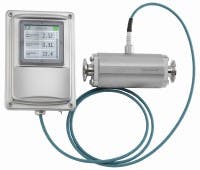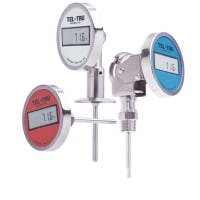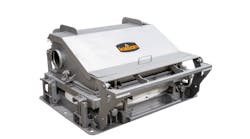(Photo at top: Advanced data management software and instrumentation can help processors monitor their operations remotely. Photo: Mettler-Toledo Product Inspection)
To maintain good health, a human being could eat well and exercise, then hope for smooth sailing. However, without the proper monitoring using the right tools to measure key health indicators, how would anyone know they were achieving good health (beyond simply feeling good)?
In many ways, food and beverage plants are similar: install equipment, streamline process flow, institute operational strategies aimed at efficiency. But without precise instrumentation and tools to monitor processes and equipment, there would be no telling how well products were being formulated, how safety was being maintained through the process, nor how truly efficient any machine was performing or when it might break down.
Instrumentation across industry monitors a wide variety of indicators, from temperatures to pressures, flow rates to fill levels, and even wear and tear on equipment and replaceable parts. In any industry, downtime is the enemy of efficient processing plants, and without proper instrumentation, plants have few opportunities to avoid unplanned downtime.
Of the 3,215 plant maintenance leaders surveyed in “Value of Reliability: ABB Survey Report 2023,” 69% reported unplanned outages at least once a month — with 8% experiencing downtime every day. Food & beverage plants made up 12% of those surveyed (the third-largest industry represented), but ABB calculated that outages cost food & beverage processors more than $84,680 per hour.
The report pointed a finger at many companies’ “run-to-fail” maintenance approach, a reactive strategy that addresses issues only when equipment malfunctions or breaks down. Changing to a more proactive, predictive strategy is where proper instrumentation comes into play.
Finely tuned instrumentation represents the glue that keeps the operational puzzle together. And as the pieces have become more complex, the monitoring equipment has had to increase its own sophistication and versatility to keep up.
Furthermore, as artificial intelligence rides the wave into the food & beverage processing space, advanced process instrumentation can flood AI modules with high-value, high-quality performance data to make condition monitoring of equipment and systems even more accurate.
Data-driven revolution
The data revolution has made instrumentation that much more important, says Sarrina Crowley, marketing communications manager for Mettler-Toledo Product Inspection (www.mt.com/pi).
Melissa Stiegler, director of food & beverage for Emerson-Measurement Solutions (www.emerson.com/en-us), sees data analytics driving requests for various monitors, as customers look for data that can help them make decisions and ultimately protect their equipment. She uses wear and tear on pumps as a primary example of an area of focus for processors.
“Being able to detect changes in process variables and equipment conditions is a great way to know the status of the pump and avoid pump damage,” she says. Emerson has a product, for example, that mounts directly on the pump and detects its vibration, then sends the data to be analyzed to determine the state of the pump.
“The customer can then prioritize their maintenance based on which pumps are more critical and closer to needing maintenance,” she adds. Similar approaches to condition monitoring can be taken for all sorts of equipment in a plant.
In an October 2023 article in Plant Services, a sister publication of Food Processing, Dave Lincoln, a digital leader for ABB Measurement and Analytics (global.abb/), explained how process instrumentation typically is already gathering and transmitting data for process control purposes, and additional instrumentation can be used to track other parameters for condition monitoring.
“Vibration and temperature are among the most common, since they can be measured non-invasively and can point to a multitude of potential maintenance issues, such as bearing wear in rotating machinery,” he said in the article. “Motor current signature analysis (MCSA) is another common approach, since a motor being used to drive worn or failing equipment will often draw power differently.”
Making monitoring easier
As if technology wasn’t making the actual equipment more technically challenging to maintain, troubleshoot and repair for the average food & beverage maintenance worker, innovations in data and instrumentation have raised the complexity for many. Crowley points to product inspection as an example where the stakes continue to rise for processing plants.
“Inspection systems that are simple to use make training of new operators much faster,” she says. “Also, the need for human intervention has been reduced with automations including fast product setup, testing, validation and data collection capabilities.”
“Inspection systems must be accurate at high speeds, and operators must have confidence that systems are functioning at their best,” Crowley says. “A new innovation in Mettler-Toledo gravity fall and throat metal detectors is the Automatic Test System which enables routine performance monitoring testing to be conducted in under 90 seconds, maximizing line uptime.”
Stiegler says helping end users access data more easily has been the focus of innovation as well, and relays that Emerson has worked to help processors use density and temperature to assess the concentration of a solution.
“This makes sure that they are using the right amount of concentrates in their production — not too much, and not too little,” she explains. “It ensures that they maintain the quality of their process, and having a product to help them do that makes it much simpler.”
In addition, Stiegler says smart meter verification can provide in-process measurement of flow meter health, which allows for confidence in measurements obtained.
Making products more intuitive and easier for plant floor workers to use can help processors with the turnover problems plaguing them today. Instrumentation on the plant floor may be able to run and collect data, but someone needs to ensure that data is collected and analyzed properly — and actionable decisions are made if an issue arises.
Proper training is required on the variety of monitoring and measurement instrumentation that food & beverage plants need — and it remains as crucial as the training needed for the larger pieces of equipment that instrumentation monitors.




